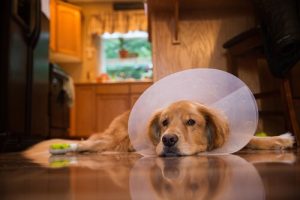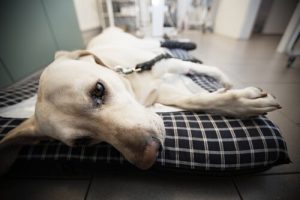7 Tips on Caring for Your Dog After Surgery

If your dog was subjected to surgical intervention, in addition to all your affection and attention, they’ll require certain special care. Continue reading to find out about the key factors for dogs to recover after an operation. Of course, these factors are based on the complexity of the surgery and the physical condition of your pet.
First steps after your dog’s operation

After the scare of the surgery has passed and your dog has been discharged, follow your vet’s instructions and recommendations to make sure your dog has a good recovery. Don’t hesitate to ask a professional any questions about your dog’s recovery. Don’t feel ashamed to ask them even if you get the impression that you’re getting annoying. The surgeon most likely will give you precise instructions on:
- How to feed your dog
- Some medication that you should give them.
- Which should be considered as a normal post-surgery complication and what would their signs be like?
- When you should take the animal for a medical check-up.
Also, keep in mind that the effects of anesthesia may take longer than expected. So don’t be scared if at first your dog seems to be stunned and has some stability issues.
When a pet has to undergo surgery — other than how clomplex it may be — pet owners are concered about how to ensure that their pet recovers quickily. Below are some tips on how to make sure your dog fully recovers after surgery.
Tips on helping your dog recover after surgery
After the first hours of the operation, your dog will recover gradually. Unless there is some kind of complication, little by little they will go back to their normal lifestyle.
When it comes to your dog having a successful recovery, consider:
- Organize your dog’s usual resting area so they can be calm and comfortable during their recovery.
- Extreme hygiene measures and make sure the room your dog is staying at has proper ventilation.
- Properly explain to the children of the house the situation that your dog is going through so that they understand that for a few days he won’t be able to be his usual playmate.
- Don’t force the animal to take long walks. Take tem out only to relieve themselve and always keep them a leash to avoid any unforeseen accidents or uncontrollable situations.
- Make sure they don’t stop drinking and eating, and that they go to the bathroom normally.
- Don’t forget to give them any remedies indicated by the veterinarian by respecting the dosage and sheduled times.
- Closely monitor the evolution of the wound.
Important information about wound care in an operated pet
In regard to your dog’s recover, it’s really important that they don’t bite or scratch their wounds. In some cases, it may be a good idea to put an Elizabethan collar on your dog. If you have other pets in your home, make sure that they don’t lick your dog’s wound and not play with him.
Also, call the vet urgently if you notice that the area of the incision heats up or has:
- Bruises
- Redness
- Swelling
- Odor
- Secretion
- Pain
Rehabilitation options in case of complex operations

In the case of complex surgeries — which can cause the loss of a lot of muscle mass — you should resort to physiotherapy or some other type of rehabilitation so your dog could have a better and faster recovery. The veterinarian will know to tell you what will be your dog’s best options.
With these techniques –laser, ultrasound, hydrotherapy, etc. — it is thought that vets can:
- Mitigate the pain.
- Decrease inflammation.
- Reduce atrophy of muscles, tendons, cartilage, and ligaments.
In any case, beyond the care and treatments, don’t forget to express your love towards your dog with words, petting them caresses and your constant presence.
If your dog was subjected to surgical intervention, in addition to all your affection and attention, they’ll require certain special care. Continue reading to find out about the key factors for dogs to recover after an operation. Of course, these factors are based on the complexity of the surgery and the physical condition of your pet.
First steps after your dog’s operation

After the scare of the surgery has passed and your dog has been discharged, follow your vet’s instructions and recommendations to make sure your dog has a good recovery. Don’t hesitate to ask a professional any questions about your dog’s recovery. Don’t feel ashamed to ask them even if you get the impression that you’re getting annoying. The surgeon most likely will give you precise instructions on:
- How to feed your dog
- Some medication that you should give them.
- Which should be considered as a normal post-surgery complication and what would their signs be like?
- When you should take the animal for a medical check-up.
Also, keep in mind that the effects of anesthesia may take longer than expected. So don’t be scared if at first your dog seems to be stunned and has some stability issues.
When a pet has to undergo surgery — other than how clomplex it may be — pet owners are concered about how to ensure that their pet recovers quickily. Below are some tips on how to make sure your dog fully recovers after surgery.
Tips on helping your dog recover after surgery
After the first hours of the operation, your dog will recover gradually. Unless there is some kind of complication, little by little they will go back to their normal lifestyle.
When it comes to your dog having a successful recovery, consider:
- Organize your dog’s usual resting area so they can be calm and comfortable during their recovery.
- Extreme hygiene measures and make sure the room your dog is staying at has proper ventilation.
- Properly explain to the children of the house the situation that your dog is going through so that they understand that for a few days he won’t be able to be his usual playmate.
- Don’t force the animal to take long walks. Take tem out only to relieve themselve and always keep them a leash to avoid any unforeseen accidents or uncontrollable situations.
- Make sure they don’t stop drinking and eating, and that they go to the bathroom normally.
- Don’t forget to give them any remedies indicated by the veterinarian by respecting the dosage and sheduled times.
- Closely monitor the evolution of the wound.
Important information about wound care in an operated pet
In regard to your dog’s recover, it’s really important that they don’t bite or scratch their wounds. In some cases, it may be a good idea to put an Elizabethan collar on your dog. If you have other pets in your home, make sure that they don’t lick your dog’s wound and not play with him.
Also, call the vet urgently if you notice that the area of the incision heats up or has:
- Bruises
- Redness
- Swelling
- Odor
- Secretion
- Pain
Rehabilitation options in case of complex operations

In the case of complex surgeries — which can cause the loss of a lot of muscle mass — you should resort to physiotherapy or some other type of rehabilitation so your dog could have a better and faster recovery. The veterinarian will know to tell you what will be your dog’s best options.
With these techniques –laser, ultrasound, hydrotherapy, etc. — it is thought that vets can:
- Mitigate the pain.
- Decrease inflammation.
- Reduce atrophy of muscles, tendons, cartilage, and ligaments.
In any case, beyond the care and treatments, don’t forget to express your love towards your dog with words, petting them caresses and your constant presence.
All cited sources were thoroughly reviewed by our team to ensure their quality, reliability, currency, and validity. The bibliography of this article was considered reliable and of academic or scientific accuracy.
- The American Society for The Prevention of Cruelty to Animals (2007) Caring for Your Dog After Surgery. Recuperado el 12 de marzo de 2022, disponible en: https://www.aspca.org/sites/default/files/caring_for_your_dog_after_surgery-_2019.pdf
- XLVets (2012) POST-OPERATIVE CARE FOLLOWING SURGERY FOR MANAGEMENT OF CRANIAL CRUCIATE RUPTURE. Recuperado el 12 de marzo de 2022, disponible en: https://rutlandvets.co.uk/wp-content/uploads/2018/04/extra-capsular_0.pdf
- Animal Welfare Fundation (2013) Pre and postoperative care. Recuperado el 12 de marzo de 2022, disponible en: https://www.animalwelfarefoundation.org.uk/wp-content/uploads/2017/03/Pre-and-Post-op-care_web.pdf
This text is provided for informational purposes only and does not replace consultation with a professional. If in doubt, consult your specialist.








